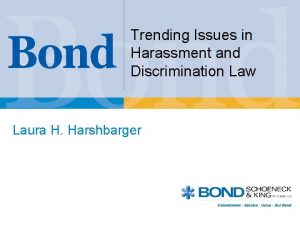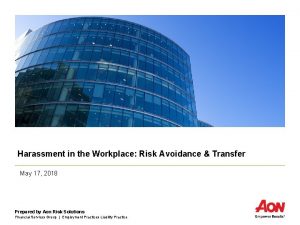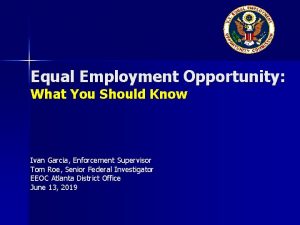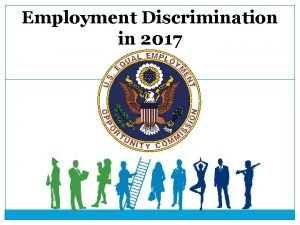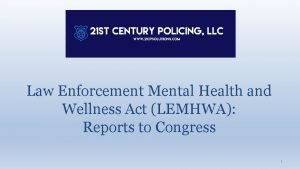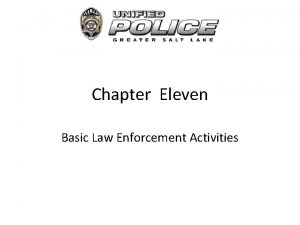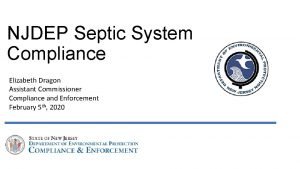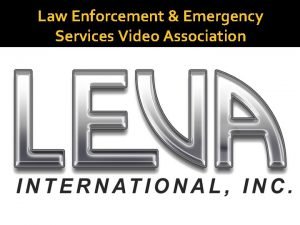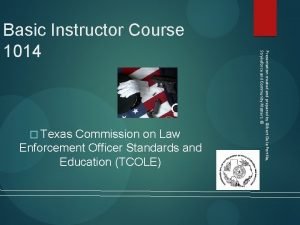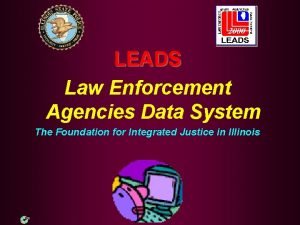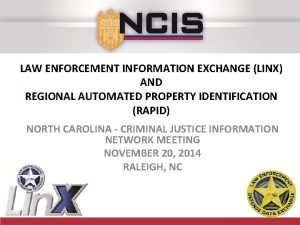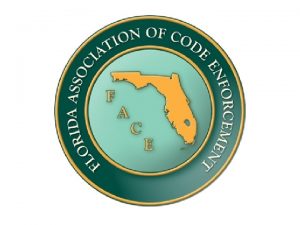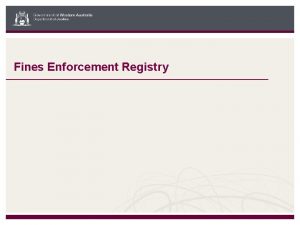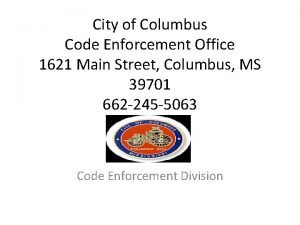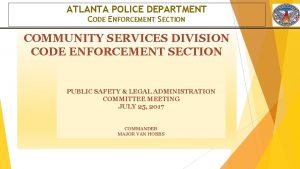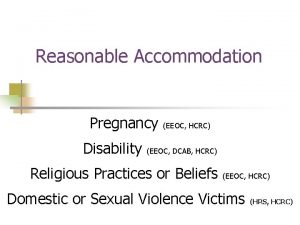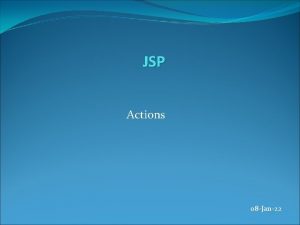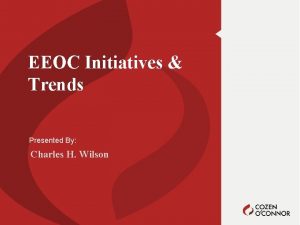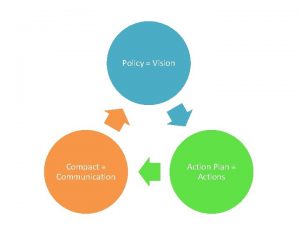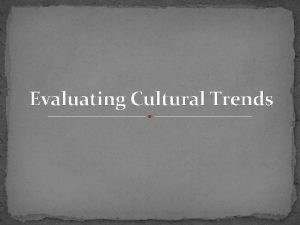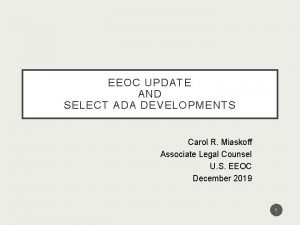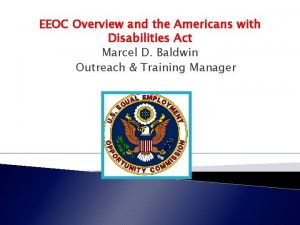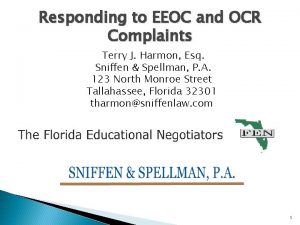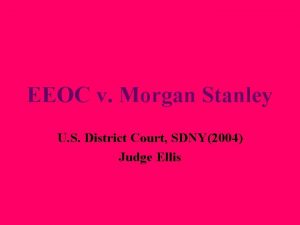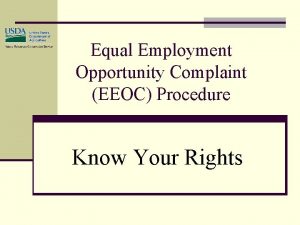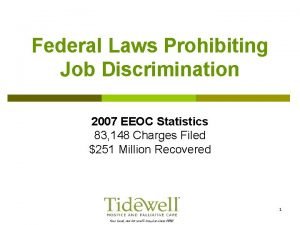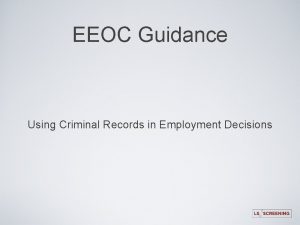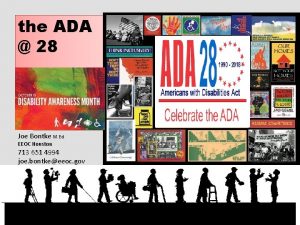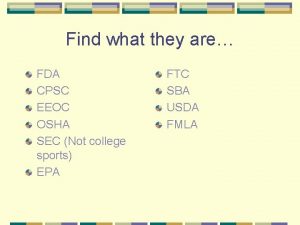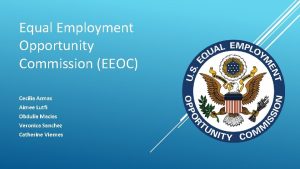EEOC Enforcement Actions and Trends EEOC Enforcement Action





























- Slides: 29

EEOC Enforcement Actions and Trends

EEOC Enforcement Action Filing A Charge n Potential Charging Party Contact with EEOC -- Walk-In -- Telephone -- Mail

EEOC Enforcement Action WHAT TO EXPECT FROM EEOC n n n Request for Information and Position Statement Mediation Investigation n n On Site Investigation Fact Finding Conference Additional Request for Information Settlement Determination n No Cause Mixed Cause n n Conciliation Litigation

Request for Information & Position Statement n n n Normally sent with Charge of Discrimination Request for Information – a questionnaire eliciting specific information regarding charging party’s allegations Position Statement – response to charging party’s allegations (your side of the story)

Take Advantage of EEOC’s Mediation Program It’s Free n It’s Voluntary n It’s Confidential n It’s Informal n Mediators are Neutrals n Investigation is Suspended During Mediation n

Make Your First Shot Your Best Shot n Position Statement Ø Ø Ø n n Respond to the Allegations in the Charge Focus on Facts Be Accurate Be Complete Base Position Statement on Internal Investigation Submit Evidence in Support of the Position Statement Submit Witness Information

Investigation n Assigned to Investigator n n n Investigator must gather facts Investigator must assess credibility Investigator must determine whether others are affected Allow investigators to do their jobs Don’t ignore due dates Request extensions if necessary

On-Site Investigation EEOC has authority under all statutes n Mutually agreed upon date at Respondent’s facility n Interview Management n Review Records n Possible Tour of Facility/Work Area n Interview witnesses n

Fact Finding Conference Tool to resolve issues in dispute n Held at EEOC office or other neutral location n Conducted by Investigator n n n Ground rules Not mediation, settlement possible Recommendation should be made at the end of the Fact Finding Conference

Additional Requests for Information Sometimes additional information needed at any point in the investigation n Written or Verbal Request n Honor due dates or seek extension, if necessary n

Settlement n Keep an open mind about settlement n n Adopt a realistic view of the case and logical reasons to consider a negotiated settlement Participate in settlement discussions If settled, Charging Party gives up Right to Sue and case is closed Settlement available at any time during the investigative process

Determination n No Cause n n n Mixed Cause n n n No cause for Charging Party but a violation has been identified Conciliation on Cause n n Charging Party gets right to Sue – 90 days to file a lawsuit Charge is closed A violation has been identified regarding Charging Party’s allegations Conciliation

Litigation n If Conciliation attempts are unsuccessful n n Dept of Justice – State/Local Government Reviewed for litigation by EEOC n n If EEOC litigates, lawsuit filed If not, Charging Party issued Right to Sue

Be aware of EEOC’s Authority to Investigate and Seek Relief EEOC has authority to investigate n EEOC has authority to subpoena evidence n EEOC has authority to expand investigations n EEOC has authority to seek relief even where the Charging Party has agreed to arbitrate n EEOC has authority to litigate n

EEOC & Enforcement Protections for LGBT Applicants & Workers Title VII of the Civil Rights Act of 1964, as amended does not explicitly include sexual orientation or gender identity in its list of protected bases. n The Commission considers coverage of lesbian, gay, bisexual and transgender individuals under Title VII’s sex discrimination provisions consistent with case law. n

Transgender/Gender Identity Sexual Orientation Gender refers to cultural aspects of masculinity or femininity. n Gender Identity – The inner sense of one’s own gender, generally as male or female. n Transgender – Choice to modify one’s gender expression and/or physical characteristics to match one’s identity. n Sexual Orientation – A person’s attraction to another person. n

Recap: Supreme Court Expansively Interprets Sex Discrimination Under Title VII n The Commission’s position on sex discrimination against LGBT individuals is consistent with long-established legal precedent. n The Supreme Court recognized decades ago that Title VII’s “because of sex” provision strikes at the “entire spectrum of disparate treatment of men and women resulting from sex stereotypes. ” Price Waterhouse v. Hopkins, 490 U. S. 228, 251 (1989) (quoting City of Los Angeles Dep’t of Water & Power v. Manhart, 435 U. S. 702, 707 n. 13 (1978) (internal citation omitted)). 17

Recap: Court Decisions on Sex Discrimination Against LGBT Individuals n Applying Price Waterhouse, courts have increasingly recognized that when an employment action is taken against an LGBT applicant or employee because of nonconformance to traditional gender stereotypes, it is actionable as sex discrimination under Title VII. Applying Title VII to LGBT individuals does not create new protected groups under the law, but rather simply recognizes the scope of the existing protected characteristic of “sex. ” Gender-stereotyping claims may be presented regardless of the sex, gender identity, or sexual orientation of the applicant or employee. 18

1. Disparate Treatment or Harassment Based on Transgender Status n Commission policy in federal and private sector cases is that discrimination against an individual because that person is transgender (also known as gender identity discrimination) is discrimination because of sex in violation of Title VII. n n n Macy v. Dep’t. of Justice, EEOC Appeal No. 0120120821, 2012 WL 1435995 (April 20, 2012). EEOC amicus brief approved for filing in Pacheco v. Freedom Buick GMC Truck, No. 07 -116 (W. D. Tex. Oct. 17, 2011), Dkt. No. 30, at page 1, 2011 WL 5410751. Rapid City Market (Minneapolis Area Office – EEOC conciliation agreement with press release dated Sept. 16, 2013, announcing resolution of claim that supermarket in South Dakota fired employee based on her transgender status in violation of Title VII). Employer agreed to payment of $50, 000, to obtain professional anti-discrimination training annually for all of its employees, to implement and distribute an anti-discrimination policy to all employees, to report all future complaints of discrimination to the EEOC, and other relief. 19

Examples of Court Decisions: Discrimination Because Individual is Transgender is Sex Discrimination n n Glenn v. Brumby, 663 F. 3 d 1312, 1316 -17 (11 th Cir. 2011) (“A person is defined as transgender precisely because of the perception that his or her behavior transgresses gender stereotypes”; “discrimination against a transgender individual because of her gender-nonconformity is sex discrimination”). Smith v. City of Salem, 378 F. 3 d 566, 575 (6 th Cir. 2004) (Title VII’s prohibition against sex discrimination includes “discrimination against a plaintiff who is a transsexual – and therefore fails to act and/or identify with his or her gender”). Rosa v. Parks W. Bank & Trust Co. , 214 F. 3 d 213 (1 st Cir. 2000) (citing Title VII case law, the court concluded that a transgender plaintiff, who was biologically male, stated a claim of sex discrimination under the Equal Credit Opportunity Act by alleging that he was denied a loan application because he was dressed in traditionally female attire). Schwenck v. Hartford, 204 F. 3 d 1187, 1201 -02 (9 th Cir. 2000) (citing Title VII case law, the court concluded that a transgender woman stated a claim of sex discrimination under the Gender Motivated Violence Act based on the perception that she was a “man who ‘failed to act like one’”). Schroer v. Billington, 577 F. Supp. 2 d 293, 308 (D. D. C. 2008) (defendant’s refusal to hire the plaintiff “after being advised that she planned to change her anatomical sex by undergoing sexreassignment surgery was literally discrimination ‘because of. . . sex’”). 20

2. Same-Sex Sexual Harassment Cases n Analyzed the same way regardless of the sexual orientation of the charging party or harasser. n As with opposite-sex harassment, it is irrelevant whether harasser’s motive was to abuse and demean or to make a sexual advance. n Oncale v. Sundowner Offshore Services, Inc. , 523 U. S. 75, 82 (1998) (same-sex sexual harassment is actionable under Title VII). 21

3. Typical Price Waterhouse Sex-Stereotyping Cases n Discrimination or harassment that is motivated by a male applicant or employee being considered too effeminate or a female too masculine. n Comments or actions motivated by employee’s perceived nonconformance to masculinity or femininity gender stereotypes with respect to dress, speech, mannerisms, or other behavior. n Analyzed the same regardless of the sexual orientation of the individual. 22

4. Cases Facially About Sexual Orientation But Actions Were Motivated By Price Waterhouse Gender Stereotypes n n n E. g. , harassment or discrimination takes the form of anti-gay comments or actions, but is motivated by a perception that the applicant or employee is too effeminate or too masculine Analyzed the same regardless of CP’s sexual orientation. Examples: n n n EEOC v. Boh Brothers Construction Co. , 731 F. 3 d 444 (5 th Cir. 2013) (jury verdict finding sex discrimination in violation of Title VII upheld; much of the harassment took the form of anti-gay epithets and other abuse, but evidence proved it was motivated by sex stereotypes, i. e. , by the harassers’ view that CP was insufficiently masculine). Rosa v. Dep’t of Veterans Affairs, EEOC Appeal No. 0120091318, 2009 WL 2513955 (EEOC Aug. 3, 2009) (harassment against a male employee including repeated innuendos about his sexuality and verbal mocking using “very feminine voice” can constitute discrimination based on sex). Nichols v. Azteca Restaurant Enterprises, Inc. , 256 F. 3 d 864 (9 th Cir. 2001) (plaintiff was subjected to a relentless campaign of verbal harassment; male co-workers and a supervisor repeatedly referred to him as “she” and “her, ” male co-workers mocked him for walking and carrying his serving tray “like a woman, ” and called him a “faggot” and a “female whore”). 23

5. Other LGBT Cases – Sex Discrimination? n What about fact patterns where the individual is not perceived to have been too masculine or too feminine in terms of sex stereotypes about dress, mannerisms, or related behavior, but rather where it is only actual or perceived sexual orientation that motivated the disparate treatment or harassment? 24

Examples n n n Discrimination or harassment based on a same-sex marriage, partnership, or other same-sex relationship n discrimination based on sex stereotype that men should only marry women can constitute discrimination based on sex); discrimination based on sex stereotype that women should only have sexual relationships with men can constitute discrimination based on sex). Discrimination or harassment based on actual or perceived sexual orientation, where there is no evidence that the individual was otherwise viewed as nonconforming to sex-stereotypes about masculinity or femininity, such as in dress, mannerisms, or other behaviors Discrimination in terms, conditions, or privileges of employment, e. g. , employer offers spousal insurance benefit for employees in opposite-sex legal marriages but not those in same-sex legal marriages. 25

Examples of Court Decisions: Discrimination Against Lesbian, Gay, and Bisexual Individuals as Sex-Stereotyping Discrimination n n Prowel v. Wise Business Forms, Inc. , 579 F. 3 d 285 (3 d Cir. 2009) (discrimination against an individual for failure to conform to gender stereotypes violates Title VII even if the discrimination was also motivated by the individual’s actual or perceived sexual orientation). Centola v. Potter, 183 F. Supp. 2 d 403, 410 (D. Mass. 2002) (“Sexual orientation harassment is often, if not always, motivated by a desire to enforce heterosexually defined gender norms. In fact, stereotypes about homosexuality are directly related to our stereotype about the proper roles of men and women. ”) Koren v. Ohio Bell Telephone Co. , 2012 WL 3484825 (N. D. Ohio Aug. 14, 2012) (denying defendant’s motion for summary judgment where plaintiff alleged his supervisor discriminated against him based on sex stereotypes because he is married to a man and took his husband’s last name; the court held: “That is a claim of discrimination because of sex”). Heller v. Columbia Edgewater Country Club, 195 F. Supp. 2 d 1212, 1224 (D. Or. 2002) (recognizing that the belief that men or women should only be attracted to persons of the opposite sex constitutes a gender stereotype). 26

Sexual Orientation is Sex-Based Discrimination n EEOC concluded in a federal sector case decision on July 15, 2015, that sexual orientation is inherently a “sex-based consideration”, and an allegation of discrimination based on sexual orientation is necessarily an allegation of sex discrimination under Title VII.

Possible Scenarios Denial of same-sex spouse benefits. n Different treatment of an employee because they are in a same-sex marriage. n Different treatment based on a personal association with someone of a particular sex. n Different treatment of a heterosexual employee by a gay supervisor because that employee is heterosexual. n

EEOC’s Web Page www. eeoc. gov Contact Information: Shirley A. Richardson Deputy District Director Memphis District Office 901/544 -0132 Shirley. richardson@eeoc. gov
 Eeo compliance training
Eeo compliance training Eeoc south africa
Eeoc south africa Eeoc discrimination
Eeoc discrimination Eeoc bullying
Eeoc bullying Eeoc atlanta district office
Eeoc atlanta district office Protected class
Protected class Law enforcement mental health and wellness act
Law enforcement mental health and wellness act Njdep ust regulations
Njdep ust regulations Military and law enforcement
Military and law enforcement Military and law enforcement
Military and law enforcement Njdep compliance and enforcement
Njdep compliance and enforcement Law enforcement video association
Law enforcement video association Medias res
Medias res What is the climax of the story the lion and the mouse
What is the climax of the story the lion and the mouse Stages of plot
Stages of plot Exposition rising action climax falling action resolution
Exposition rising action climax falling action resolution Suit the action to the word the word to the action meaning
Suit the action to the word the word to the action meaning Trends of media and information
Trends of media and information Texas commission on law enforcement
Texas commission on law enforcement Second line enforcement
Second line enforcement Crane night vision lease program
Crane night vision lease program Mto enforcement officer
Mto enforcement officer Leads provides access to
Leads provides access to Law enforcement linx
Law enforcement linx Florida association of code enforcement
Florida association of code enforcement Fines enforcement number
Fines enforcement number Columbus code enforcement
Columbus code enforcement Atlanta code enforcement
Atlanta code enforcement Virginia law enforcement assistance program
Virginia law enforcement assistance program Nllea
Nllea


